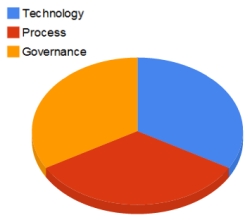 I found Going overboard with Social CRM by Gartner’s Michael Maoz to be a discouraging read. In it he expresses frustration at potentially shortsighted adoption of “social CRM” in these closing sentences:
I found Going overboard with Social CRM by Gartner’s Michael Maoz to be a discouraging read. In it he expresses frustration at potentially shortsighted adoption of “social CRM” in these closing sentences:
Much of what you are going to hear when you give customers the tools to engage one another are the exact things that you are not organized to hear today. What will make you any more ready to do something about the insights? Bottom line: if you are not ready to change your approach to supporting the customer, put on your lifejacket before you get too far into a Social CRM project, because chances are you’ll be swept overboard.
What I found as I read Michael’s post (and found my head nodding in agreement) was how familiar the underlying refrain is, i.e., all too often an integrated approach to customer service is needed so that everyone who touches the customer is speaking from the same play-book — but the company/association/government agency/etc. is not organized to manage such an integrated approach.
I’ve been hearing the “we need integrated customer service management” song for over two decades, first while participating in developing customized network based support systems for large call centers, then while developing national support strategies for customized point of sales devices, now while developing communication strategies for large Federal programs.
As Maoz points out, it’s not a technology problem, even though management and vendors often approach it that way. Plus, there’s more involved than just getting IT, marketing, and Customer Service (and Accounts Receivable) into the same room together. There have to be channels to ensure that both strategy and tactics for all three key areas — Technology, Process, and Governance — will be coordinated and synchronized.
 Will such coordination take place? And is there any reason to believe that “social CRM” will fare any better than past “technologies” that have solved only part of the customer communication problems?
Will such coordination take place? And is there any reason to believe that “social CRM” will fare any better than past “technologies” that have solved only part of the customer communication problems?
If I’m reading Maoz correctly, maybe not, but that’s assuming the problem is approached primarily as a technology problem.
A lot will depend on how the organization recognizes the need for and manages change. Some organizations do already approach customer communication in an integrated fashion. While they may rely heavily on technology to support post-sale customer support, they also know how to respond to how easy it is for a customer to bounce back and forth between a sales focus and a customer service focus.
In some cases employees themselves will start by “backing in” to doing customer support via public networks like Facebook, and then management is forced to follow. “Going where the customer is” almost forces reliance by default on external communications networks these days. (Even so, not having worked out the process and governance issues in advance can result in somene else defining your customer communication strategy, as now appears to be the case with Facebook and its automatic creation of community pages that seem to compete with “official” pages.)
Perhaps one key to successful social CRM adoption is recognizing that it will never be possible in any real organization to have a single system, database application, or any other technology that supports 100% of customer transactions. There will always be integration and legacy system issues to consider along with emerging cloud based system opportunities. Successfully integrating internal and external systems, public and private networks, and social and legacy systems may remain a pipe dream for many years.
Given some of the realities of social CRM, maybe it would just be cheaper and more effective for the people in an organization to collaborate with each other instead of attempting expensive - and potentially fruitless — integration of all the systems, data, and processes that everyone uses in connection with customer communication.
Copyright (c) 2010 by Dennis D. McDonald
Related articles include:
- Social Networking, Performance Improvement, and Service Differentiation: A Rising Tide
- Should Everyone in an Organization Have Customer Service Responsibilities?
- How Closely do Traditional and Social Media Based Customer Support Services Need to be Coordinated?
- Highlights from “Web 2.0 and Sales Process Management”
- Promoting Technology Enabled Collaboration in Complex R&D Environments


